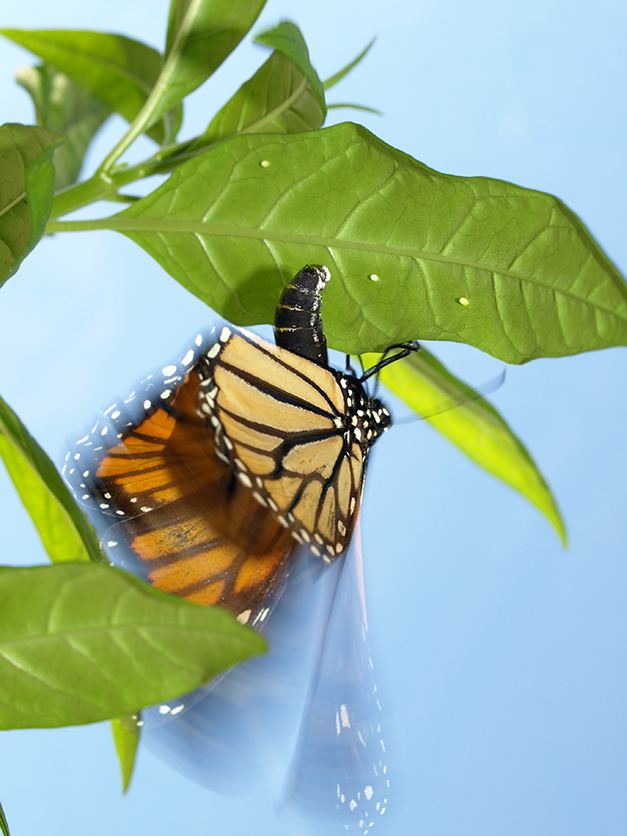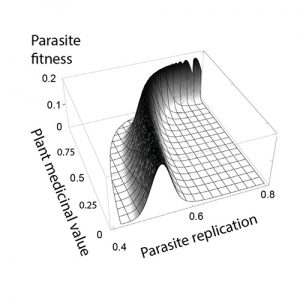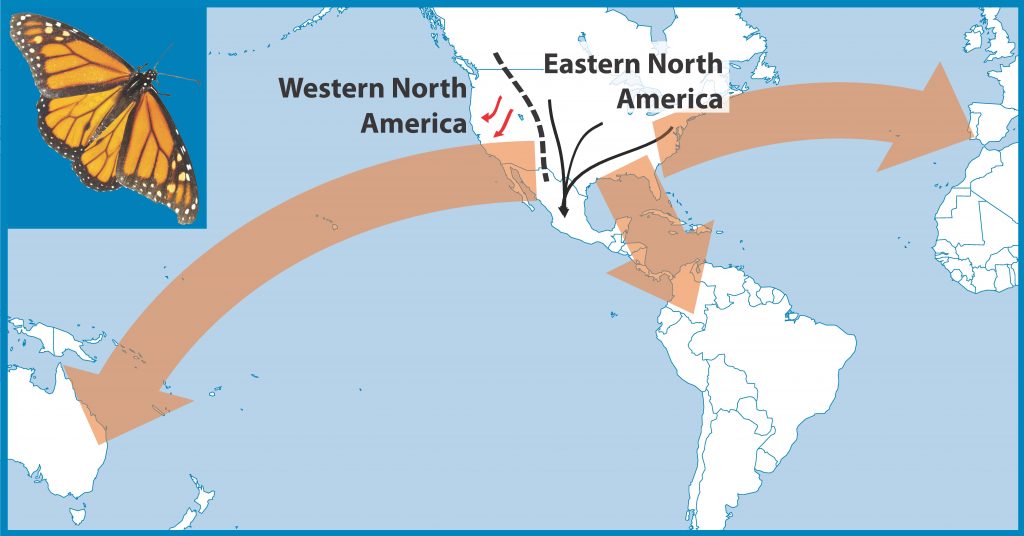Current Research
Monarch medication
Because parasites cause disease and death in their hosts, there should be strong selection for hosts to evolve ways to protect themselves against parasites. Monarch butterfly larvae are specialist feeders on milkweeds, but they can use up to 30 milkweed species. Milkweeds vary in their concentrations of toxic secondary chemicals known as cardenolides. Our collaborative work with Mark Hunter (University of Michigan) has shown that milkweeds with high concentrations of cardenolides provide protection against protozoan parasites, thus acting as medicinal plants. This finding led us to investigate whether monarchs can actively use milkweeds as a form of medication. In a series of experiments, we found that monarch caterpillars cannot actively choose medicinal plants when infected. Intriguingly, however, infected female butterflies preferentially lay their eggs on milkweed species that make their offspring less sick. This suggests that monarch butterflies have evolved the ability to medicate their offspring, and also demonstrates that wild animals can use medication against parasitic infections.

A monarch laying eggs on the medicinal milkweed Asclepias curassavica. Infected monarchs prefer to lay their eggs on this medicinal milkweed over the non-medicinal Asclepias incarnata, reducing infection and disease symptoms in their offspring.
Questions:
- What is the relationship between milkweed toxicity and medicinal value?
- Do medicinal plants have negative side effects for monarchs?
- What is the role of monarch sight, smell and taste in choosing medicinal plants?
- How do other species, such as aphids and mycorrhizal fungi, change the chemistry of milkweed plants and alter their medicinal properties?
Therapeutic medication and prophylaxis
How does parasite risk drive the evolution of medication behaviors? Our theoretical work suggests that low parasite risk should select for therapeutic medication (i.e. “taking medicine when sick”) while high risk should select for prophylaxis (i.e. “taking medicine preventatively”). So far, we have demonstrated therapeutic medication in butterflies from eastern and western North America, where parasite risk is low, and prophylaxis in monarchs from South Florida, where parasite risk is high. We are expanding this work to test for medication behaviors in monarchs from other populations around the world.
Questions:
- What is the relationship between parasite infection risk and the evolution of medication behavior?
- How do milkweed diversity and toxicity affect the evolution of medication?
- How does medication by an individual monarch affect parasite prevalence does medication result in ecological feedbacks?
Plant chemistry, immunity and the microbiome
Our work shows clear correlations between the concentrations and toxicity of milkweed cardenolides and their medicinal properties. However, it is not quite clear yet how these chemicals reduce parasite infection and disease symptoms, and how they interact with monarch immunity and the monarch gut microbiome. Medicinal milkweeds could either increase monarch immunity (perhaps by priming or stimulating the anti-parasite immune components) or reduce monarch investment in immunity (because monarchs may not need immunity when using medicinal compounds instead). It is also possible that milkweed chemicals alter the gut microbiome of monarchs and that these gut microbes play a role in reducing parasite infection and disease symptoms. We are investigating these questions by characterizing the monarch immune system and by characterizing and manipulating the monarch microbiome.

The secondary chemicals in medicinal milkweeds could directly interfere with parasites. Medicinal milkweeds could also enhance monarch immunity or change the gut microbiome to increase parasite resistance.
Questions:
- What immune pathways do monarchs employ against their protozoan parasites?
- Do medicinal milkweeds reduce or enhance immunity in monarchs, and how do medicinal milkweeds alter selection on immune genes in natural populations?
- Do monarchs on different milkweeds harbor different microbiomes?
- Can the medicinal properties of medicinal milkweeds be transferred between monarchs through microbiome transplants?
Medicinal milkweeds and evolution of parasite virulence
Theory suggests that imperfect vaccines – which reduce parasite growth but do not prevent infection – may select for more virulent parasites, because they should select for parasites that overcome the reduced parasite growth imposed by the vaccine. Similar evolution may occur on the basis of other anti-parasitic treatment, including drugs and medicinal milkweeds. We have analyzed theoretical models and found that medicinal milkweeds, by selecting for parasites that overcome milkweed toxicity, can favor more virulent parasites. We are using empirical studies to test these theoretical predictions. We are planning laboratory selection experiments and comparisons of virulence of parasites from populations of monarchs that vary in their use of medicinal milkweed. This work will provide an important test of the hypothesis that anti-growth resistance, as can be conferred by food plants or imperfect vaccines – can select for more virulent parasites.

Theoretical work shows that medicinal plants can select for parasites with higher levels of intrinsic virulence.
Questions:
- Do parasites in monarchs reared on medicinal milkweed evolve higher virulence than those in monarchs reared on non-medicinal milkweed?
- Are parasites from populations in which monarchs medicate more often, more virulent than those from populations in which monarchs medicate less?
Population genetics of monarchs around the world
Monarchs are well known for their annual migration from eastern North America to overwintering sites in Mexico, but they also occur in western North America, where they overwinter along the Californian coast. Furthermore, monarchs form non-migratory populations around the world, ranging from locations in New Zealand to Costa Rica and Spain. Although these different populations have been known for a long time, it remained unknown how monarchs spread around the world and whether monarchs in different populations are genetically different. We addressed these questions using multiple techniques, including whole-genome sequencing. Surprisingly, this work showed that monarchs originate in North America, and that they subsequently colonized the world through independent dispersal events across the Atlantic Ocean, across Central and South America, and across the Atlantic Ocean. During these dispersal events, monarchs formed genetically distinct populations and lost their migration. Another surprising finding was that monarchs in eastern and western North America, despite their drastically different migration destinations and distances, do not show genetic differentiation, suggesting that their differences in migration are driven by gene expression.
Questions:
- How much gene flow occurs between different populations of monarchs?
- Has genetic differentiation between monarch populations contributed to local adaptation?
- Are there specific genomic regions that show strong genetic differentiation between migratory monarchs with different migration distances and destinations?

Monarchs in eastern North America migrate to Mexico (black arrows) while those in western North America overwinter along the California coast (red arrows). Monarchs originate in North America and colonized the world through three independent dispersal events (orange arrows).
The genetics of seasonal migration
The occurrence of natural variation in migration distance, and the three independent losses of migration during their worldwide dispersal, make monarchs a wonderful system to study the genetic basis of migration. Our work has shown that non-migratory monarchs have smaller wings than migratory monarchs, and collaborative work has shown genetic differentiation between migratory and non-migratory monarchs at a number of genetic loci involved in muscle functioning and metabolism. Current work is indicating that muscle-related genes are also differentiated between eastern and western North American butterflies, and that eastern monarchs have greater flight endurance than western monarchs. We are expanding this work to include genetic crosses between monarchs that vary in migration phenotypes to further our understanding of monarch migration.
We are addressing the following questions:
- How do migratory and non-migratory monarchs differ in morphology, development, flight speed and flight orientation?
- What genes are involved in the initiation and execution of monarch migration?
- Can we knock out candidate genes to unequivocally demonstrate the role of particular genes in migration phenotypes?

Monarchs from eastern North America migrate to overwintering sites in central Mexico, where they aggregate in the millions.


